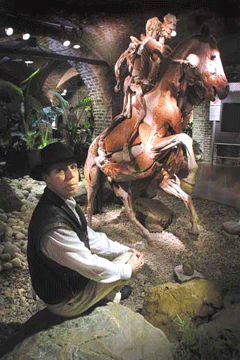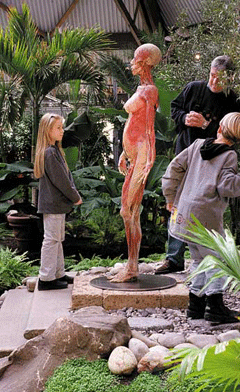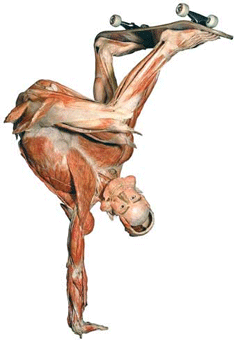Body Worlds
Air Date: Week of October 27, 2006

Gunther von Hagens and the plastinate "The Rearing Horse with Rider" in Brussels, Belgium. (Photo: © Gunther von Hagens Institute for Plastination Heidelberg, Germany http://www.bodyworlds.com/)
It’s often been said that the human body is a work of art. But what about preserving real human corpses, arranging them in various poses, and creating a museum exhibit around them? Living on Earth’s Dennis Foley visited the controversial exhibit "Body Worlds" at the Boston Museum of Science and brings us an audio portrait.
Transcript
CURWOOD: And now we move from outer space to inner space. Plastination is the extraction of bodily fluids from human and animal cadavers, replacing them with hardening resins and elastomers, and then posing the bodies in perfectly rigid forms.
This seemingly morbid type of corpse preservation was created by a German doctor, Gunther von Hagen, as a novel way to study human anatomy, and it has been the subject of a controversial exhibition touring the U.S. called “Body Worlds.”
Living on Earth’s Dennis Foley spent a day at the Boston Museum of Science to collect some insights from a few of the living bodies walking around the exhibit, and has this audio portrait.

Gunther von Hagens and the plastinate “The Rearing Horse with Rider” in Brussels, Belgium.(Photo: © Gunther von Hagens, Institute for Plastination, Heidelberg, Germany, http://www.bodyworlds.com)
[HEART BEATING]
RECORDING: This plastinate shows the thinker. Sitting deep in thought, watching and observing.
[MUSIC: The Stranglers “Waltz In Black” from ‘The Gospel According to the Men In Black’ (EMI – 1981)]
WOMAN: I think it’s gross.
WOMAN: It’s so…it’s funny.
WOMAN: It’s gross.
MAN: No, no, no, this is not entertainment. This is information. There’s a lot of difference between entertainment and information.
WOMAN: The person is gone. It’s just the body. The body’s going to rot anyway, so why not use it for educational purposes?
GIRL: A person’s body with only muscles, and they took out the bones of it, and then the bones are over there.

The Woman Bearing Life.(Photo: © Gunther von Hagens, Institute for Plastination, Heidelberg, Germany, http://www.bodyworlds.com/)
WOMAN: They clearly are people. The fact that the name isn’t offered to us doesn’t change that.
MAN: Well, I think that’s what makes it easier on people—the fact that it is anonymous. If you knew exactly each and every corpse in the place, then it’s going to freak the crap out of everybody, but….
WOMAN: If you’re going to go so far as to position the bodies in a lifestyle, then you need to, you know, give them an actual personality, as opposed to just a body.
MAN: I don’t know. I’d donate my body to it.
MAN: To be displayed like this would be a, you know, you’re being made into a statue. So, I can see why people would volunteer to donate their body to this particular exhibit.
WOMAN: I have two boys and I could never, ever, ever, ever, in my life, have them displayed like this, ever.
MAN: Well, I wouldn’t want my family going through something like this. I wouldn’t want them, you know, knowing that I’m off in a museum somewhere.
GIRL: It sort of creeps me out, but, I don’t know, just that the feeling that these were real people, that you’re actually just looking at them.
MAN: Yeah, the internal organs, the chest and the abdominal cavity. And they’ve made it so that she looks like she’s diving off of a platform.

The Skateboarder.(Photo: © Gunther von Hagens, Institute for Plastination, Heidelberg, Germany, http://www.bodyworlds.com)
MAN: It’s truly a remarkable dissection. You know, it truly is artwork.
BOY: Like Muscle Man, it’s kicking the soccer ball.
MAN: It’s just the eyes.
WOMAN: (laughs)
MAN: The eyes, just looking at me. It felt like they were just staring into me.
MAN: I would think part of the point of the bodies exhibit is to show what’s, kind of, going on inside of all of us.
WOMAN: This is what I look like on the inside.
MAN: It’s just exactly what you are underneath.
WOMAN: I don’t like how, like, we’re on display out here like that. It’s freaking me out.
WOMAN: They didn’t turn to ashes. They didn’t disintegrate. They’re just still intact.
WOMAN: How does it make you feel to look at all these?
CHILD: Scared.
WOMAN: Yeah?
CHILD: Me, too, scared!
WOMAN: Maybe mom made the wrong decision.
MAN: As much as it is disturbing and controversial, it’s something we need to know.
CURWOOD: Our “Body Worlds” sound portrait was produced by Living on Earth’s Dennis Foley. To take a peak at Dr. Von Hagen's work, visit our website at www.loe.org
Links
Living on Earth wants to hear from you!
Living on Earth
62 Calef Highway, Suite 212
Lee, NH 03861
Telephone: 617-287-4121
E-mail: comments@loe.org
Newsletter [Click here]
Donate to Living on Earth!
Living on Earth is an independent media program and relies entirely on contributions from listeners and institutions supporting public service. Please donate now to preserve an independent environmental voice.
NewsletterLiving on Earth offers a weekly delivery of the show's rundown to your mailbox. Sign up for our newsletter today!
 Sailors For The Sea: Be the change you want to sea.
Sailors For The Sea: Be the change you want to sea.
 The Grantham Foundation for the Protection of the Environment: Committed to protecting and improving the health of the global environment.
The Grantham Foundation for the Protection of the Environment: Committed to protecting and improving the health of the global environment.
 Contribute to Living on Earth and receive, as our gift to you, an archival print of one of Mark Seth Lender's extraordinary wildlife photographs. Follow the link to see Mark's current collection of photographs.
Contribute to Living on Earth and receive, as our gift to you, an archival print of one of Mark Seth Lender's extraordinary wildlife photographs. Follow the link to see Mark's current collection of photographs.
 Buy a signed copy of Mark Seth Lender's book Smeagull the Seagull & support Living on Earth
Buy a signed copy of Mark Seth Lender's book Smeagull the Seagull & support Living on Earth

